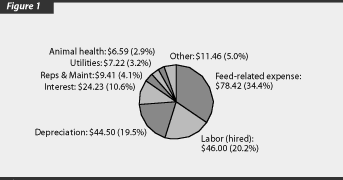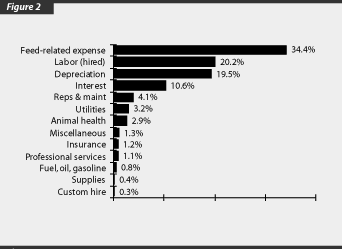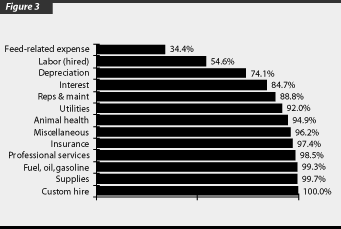What's your
|
November and December, 1996 |
Will Marsh
Copyright (C) 1996, American Association of Swine Practitioners.
Pie charts are useful for showing how a statistic can be broken down into its component parts. The convention for producing a pie chart is to first draw a circle, then draw a line from the center of the circle to its circumference at the "twelve o'clock" position. Proceeding in a clockwise direction, the circle is divided into segments representing the proportional contribution of each component to the total. In the example on the front cover (also shown here as Figure 1), the values have been sorted in declining order of -importance. Thus, hired labor, depreciation, and interest are the second, third, and fourth largest contributors to the total, respectively. A limitation of pie charting becomes apparent when we need to subdivide a statistic into more than eight to ten components. The more segments we add, the smaller they tend to become. Clear labeling becomes difficult. It also becomes extremely difficult for the reader to differentiate between segments of nearly equal proportions. However, the same data can easily be displayed as a horizontal bar chart (Figure 2). Note that the use of the bar chart format has permitted us to expand the "other" category from Figure 1 to provide more detail of the minor financial account categories. A useful combination of the attributes of the pie chart and the horizontal bar chart is the cumulative bar chart (Figure 3). Reading from top to bottom, it is easy to see that "feed-related expense" and "hired labor" together account for 54.6% of the estimated $227.83 cost of producing a litter of weaned pigs. By adding "depreciation" and "interest" to that list we can now account for 84.7% of the cost of production. Almost 95% of the total cost is accounted for by the top seven categories. |
   |
Ask your clients to provide you with the data needed to construct these simple charts. If they cannot, or if the proportional contributions of the major categories vary markedly from this example, then their financial accounting systems may be in need of a major overhaul.
